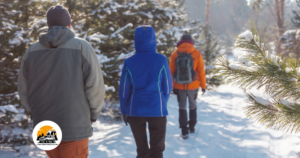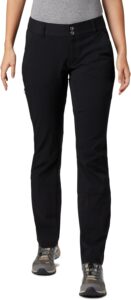What comes to your mind when you think about winter hiking? Is it the crisp air, the breathtaking, snow-covered landscapes, or perhaps the unique sense of adventure? Whatever it is, preparing for such an outing is crucial, especially when it comes to what you wear. Proper attire can make or break your experience in the great outdoors during the winter months.
Understanding the Weather Conditions
Before you even think about clothing, it’s important to understand the weather conditions you might face. Winter weather can be unpredictable, encompassing anything from frigid temperatures to snowstorms.
Temperature Range
Knowing the anticipated temperature range is essential. This information will guide your decisions on layering and materials.
Wind Chill Factor
Wind chill can make it feel much colder than the actual temperature. Be prepared to account for this by wearing wind-resistant layers.
Layering: The Key to Comfort
When it comes to winter hiking, layering is your best friend. Wearing multiple layers allows you to regulate your body temperature effectively.
Base Layer
Your base layer is the first line of defense against the cold. It should fit snugly against your skin to wick moisture away while providing warmth.
- Material Choices: Opt for materials like merino wool or synthetic fabrics designed for moisture-wicking.
- What to Look For: A long-sleeve shirt and thermal leggings are great choices for men and women.
Insulating Layer
The insulating layer traps body heat and keeps you warm. This layer should also be breathable to avoid overheating.
- Material Choices: Fleece, down, or synthetic insulation work well.
- What to Look For: A fleece jacket or down vest can add that extra warmth you need on colder days.
Outer Layer
Your outer layer acts as a barrier against the elements—most importantly, wind and moisture.
- Material Choices: Look for waterproof or water-resistant jackets and pants.
- What to Look For: A breathable shell jacket with good ventilation options will help you stay dry even if you start to sweat.
Choosing the Right Footwear
Your choice of footwear can significantly impact your comfort and safety while hiking in winter conditions.
Insulated Hiking Boots
Insulated boots are essential for keeping your feet warm and dry.
- Features to Consider: Look for waterproof materials and thermal insulation. Gaiters are a great addition to prevent snow from entering your boots.
- What to Look For: Boots with a good grip and ankle support are advisable for navigating slippery terrains.
Socks
The importance of choosing the right socks cannot be overstated. They play a significant role in ensuring warmth and preventing blisters.
- Material Choices: Wool or synthetic fibers are ideal, as they wick moisture and keep your feet warm even when damp.
- What to Look For: Avoid cotton socks, and opt for medium-thickness socks for the best fit within your boots.
Accessories Make a Difference
Accessories are often overlooked, but they can greatly enhance your winter hiking experience.
Hats
A considerable amount of heat escapes from your head, so wearing a warm hat is crucial.
- Material Choices: Fleece, wool, or synthetic fabrics are great options.
- What to Look For: A snug but comfortable fit that can trap heat and keep your ears warm.
Gloves or Mittens
Your hands should be protected from the cold, whether you prefer gloves or mittens.
- Material Choices: Insulated gloves are necessary, while mittens can give additional warmth.
- What to Look For: Waterproof materials are a must to keep your hands dry.
Neck Gaiter or Buff
A neck gaiter can help shield your neck and face from biting winds.
- Benefits: Besides warmth, it can easily be pulled up or down based on rising temperatures.
- What to Look For: Choose a breathable fabric that can be worn multiple ways.
Sun Protection is Still Necessary
Even in winter, the sun can be strong, especially when it reflects off snow.
Sunglasses
Investing in good-quality sunglasses is important, as it can reduce glare and protect your eyes from UV rays.
- Features to Consider: Look for 100% UV protection and polarizing lenses for the best experience.
Sunscreen
Don’t forget to apply sunscreen on exposed skin, even if it’s cloudy.
- What to Look For: A broad-spectrum sunscreen with a high SPF will offer the best protection against harmful rays.
Navigating Ice and Snow
Dealing with ice and snow presents unique challenges, and your gear can significantly affect your safety.
Crampons and Microspikes
If you’re planning a hike on icy trails, consider using crampons or microspikes.
- Benefits: They provide additional traction and help to prevent slipping.
- What to Look For: Easy-to-attach models will save you time when you’re on the trail.
Trekking Poles
Trekking poles can provide stability and reduce the strain on your joints.
- When to Use: They are particularly useful on steep inclines or declines where slipping is a concern.
- What to Look For: Adjustable lengths and durable materials are key features.
Staying Hydrated
Staying hydrated in winter is just as important as in the summer. However, drinking water when it’s cold can be a challenge.
Insulated Water Bottles
Using insulated water bottles can help prevent your water from freezing.
- What to Look For: Choose bottles that will keep your beverage warm or cold for extended periods.
Hydration Packs
Some hikers prefer using hydration packs for easy access to water, but they require insulation against freezing.
- What to Look For: Insulated reservoirs and tubes will maintain your water temperature.
Understanding Your Trail
Before you hit the trail, it’s essential to know where you’re going and what you’ll encounter along the way.
Researching Trails
Choose trails that are suitable for winter hiking and check for current conditions.
- What to Look For: Websites, local hiking groups, or park services provide valuable information on conditions and closures.
Trail Maps and Apps
Always carry a physical map or have a downloaded version on your phone. GPS can be unreliable in remote areas.
- What to Look For: Look for apps that work offline and provide topographic information for better navigation.
Important Safety Tips
Keeping safety in mind is essential for a successful winter hike.
Always Hike with a Buddy
Hiking with a friend or group can be safer in case of emergencies.
- Benefits: Not only is it safer, but it’s also more fun to share the experience.
Let Someone Know Your Plans
Always inform someone about your hiking plans, including your route and estimated return time.
- What to Look For: A simple text message can help ensure someone knows to look for you in case plans change unexpectedly.
Know When to Turn Back
It’s crucial to recognize when conditions are becoming hazardous.
- Signs to Watch For: Sudden weather changes, fatigue, or icy trail conditions signal that it might be time to head back.
Embracing the Adventure
Winter hiking can be incredibly rewarding, offering stunning views and a sense of peace that you can’t find in warmer months.
Finding Joy in Nature
Take time to appreciate the beauty of winter landscapes. The tranquility of a snow-covered forest or the silence that comes with falling snow is enchanting.
Listening to Your Body
Remember to listen to your body and take breaks as needed. Staying attuned to your physical state will make your adventure more enjoyable and safer.
Celebrating Your Accomplishments
After a successful hike, don’t forget to celebrate your achievements. Whether it’s treating yourself to a hot drink or sharing your adventure with friends, recognition of your hard work is essential.
Final Thoughts
So, what will you wear on your next winter hike? Whatever path you choose, being well-prepared and properly dressed can enhance your experience, ensuring warmth, comfort, and safety. Remember, winter hiking is all about enjoying the beauty of nature, so take the time to prepare properly, and your adventure will be all the more rewarding.
Disclosure: As an Amazon Associate, we earn from qualifying purchases.




